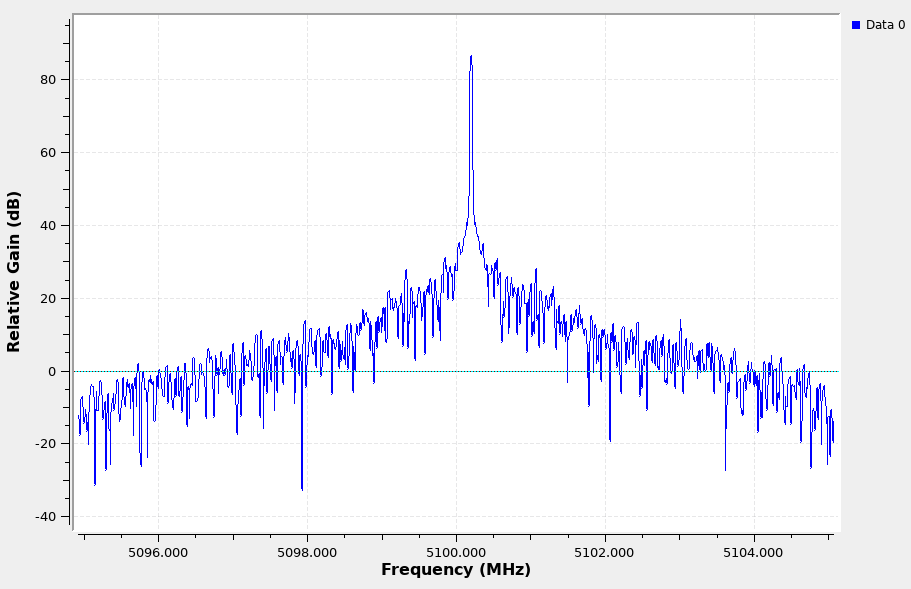Performance Measurements
Phase Noise Profiles and Spectrum Graphs
Reference Clock
Test conditions
The Ref Clock is configured with an internal 10 MHz reference. A 50R cable was used to connect Crimson TNG to a Rhode and Swartz FSW Signal and Spectrum Analyzer where we captured the results.
Measurement Results
Figure 1: Phase Noise of Reference Clock
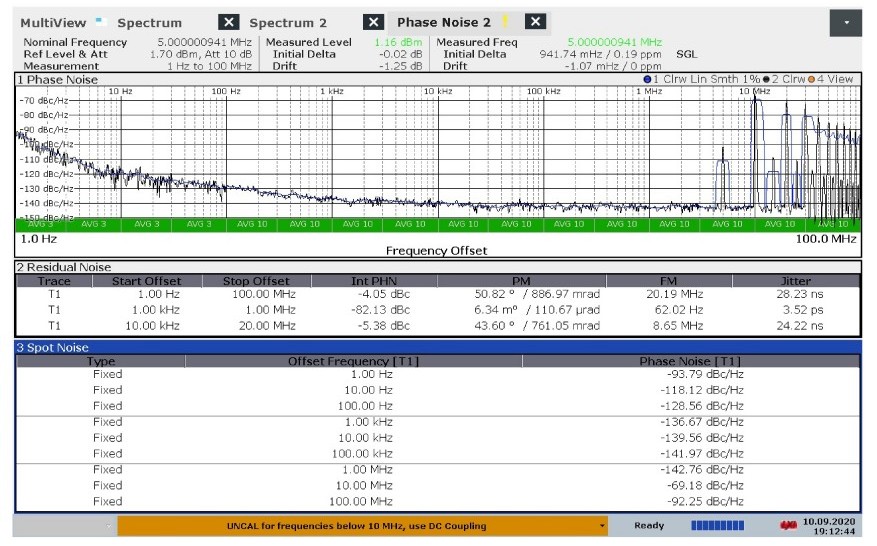
Figure 2: Spectrum of Ref Clock
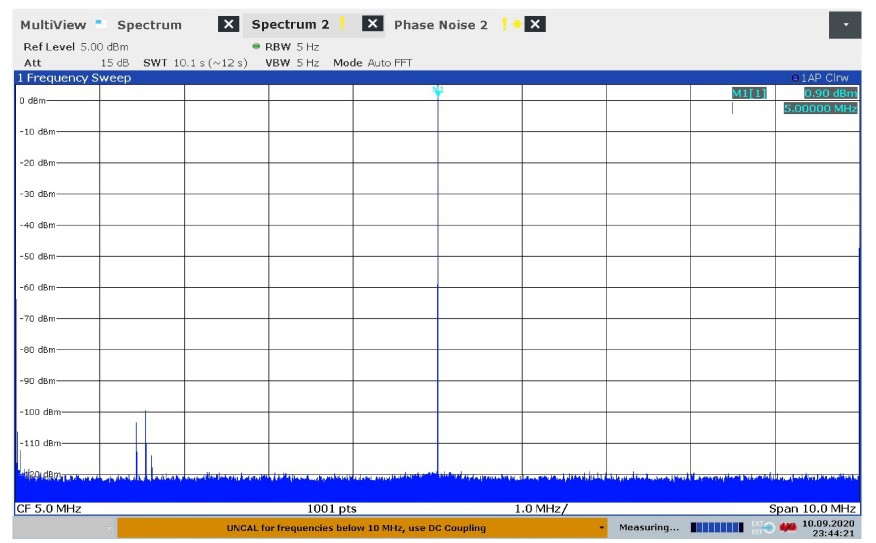
Device Clock
Test conditions
The Dev Clock, used for converters, operates at 325MHz (Configured with internal 10MHz reference). A 50R cable was used to connect Crimson TNG to a Rhode and Swartz FSW Signal and Spectrum Analyzer where we captured the results.
Measurement Results
Figure 3: Phase Noise profile of Dev Clock
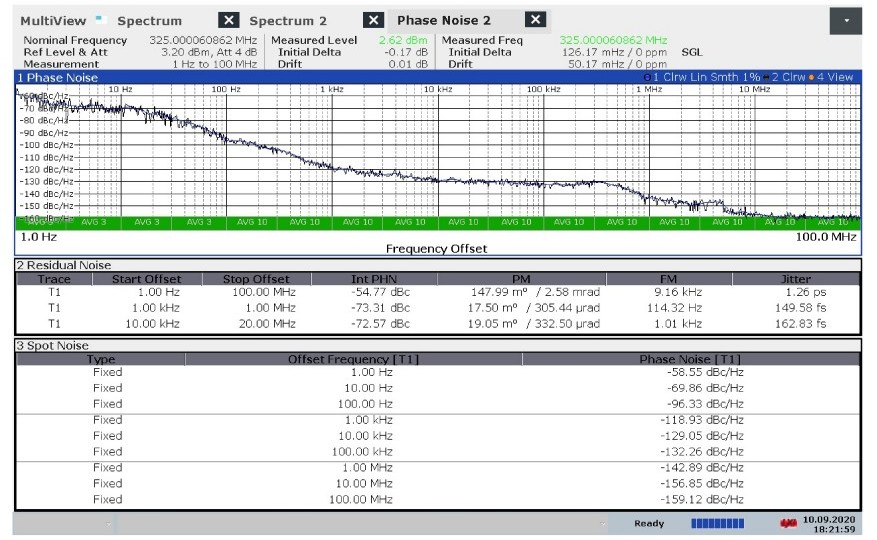
Figure 4: Spectrum of Dev Clock
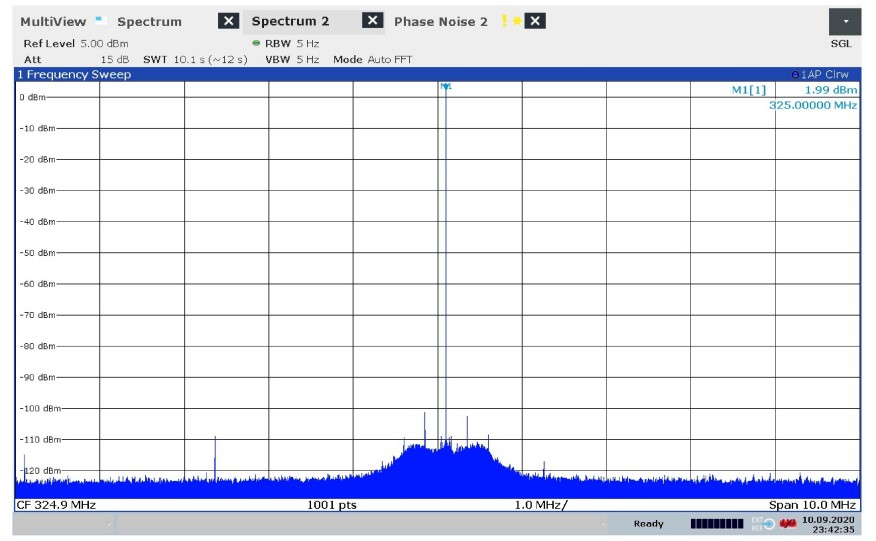
Tx Waveform Performance Measurements
Note on Phase Noise
Note
PHASE NOISE MEASUREMENTS: The following phase noise measurements were taken using the default 10MHz PDF, which provides for a default RF frequency tuning step size of 10MHz. This decision was made to support the widest possible use cases from our customers. However, these measurements do not reflect the best possible performance of our product; for phase noise sensitive applications, the phase noise profile can be improved by over 12dB. Please contact us for more information.
In this section, you will find the command to create the Normalized 0 dBm Spectrum (SNR) plot shown, and a .pdf file of all phase noise and dynamic range measurements.
Test conditions
Measurements were taken using a Rhode and Swartz FSW Signal and Spectrum Analyzer. The RF port of the phase noise analyzer was connected to the Tx A port. Waveforms were generated using tx_waveforms, an example program that is included with libUHD, and run with the specified command options required to obtain a 0dBm output measurement.
Tx Measurements at 50 MHz
Normalized 0 dBm Spectrum Command
sudo ./tx_waveforms \
--rate 16250000 \
--ampl 0.7 --gain 6.0 \
--wave-type SINE \
--wave-freq 100000 \
--channels "0" \
--freq 50000000Measurement Package
Crimson TNG 50 MHz Tx Measurements: this includes phase noise and spectrum measurements for the above configuration.
Note
Phase noise measurements are based on standard 10MHz PDF. See note on phase noise.
Figure 5: Normalized 0 dBM Spectrum at 50MHz (SNR)
Tx Measurements at 500 MHz
Normalized 0 dBM Spectrum Command
sudo ./tx_waveforms \
--rate 16250000 \
--ampl 0.7 --gain 14.75 \
--wave-type SINE \
--wave-freq 100000 \
--channels "0" \
--freq 500000000Measurement Package
Crimson TNG 500 MHz Tx Measurements: this includes phase noise and spectrum measurements for the above configuration.
Note
Phase noise measurements are based on standard 10MHz PDF. See note on phase noise.
Figure 6: Normalized 0 dBM Spectrum at 500MHz (SNR)
Tx Measurements at 1.5 GHz
Normalized 0 dBm Output Command
sudo ./tx_waveforms \
--rate 16250000 \
--ampl 0.7 --gain 20.25 \
--wave-type SINE \
--wave-freq 100000 \
--channels "0" \
--freq 1500000000Measurement Package
Crimson TNG 1.5 GHz Tx Measurements: this includes phase noise and spectrum measurements for the above configuration.
Note
Phase noise measurements are based on standard 10MHz PDF. See note on phase noise.
Figure 7: Normalized 0 dBM Spectrum at 1.5GHz (SNR)
Tx Measurements at 2.8 GHz
Normalized 0 dBm Output Command
sudo ./tx_waveforms \
--rate 16250000 \
--ampl 0.7 --gain 20.75 \
--wave-type SINE \
--wave-freq 100000 \
--channels "0" \
--freq 2800000000Measurement Package
Crimson TNG 2.8 GHz Tx Measurements: this includes phase noise and spectrum measurements for the above configuration.
Note
Phase noise measurements are based on standard 10MHz PDF. See note on phase noise.
Figure 8: Normalized 0 dBM Spectrum at 2.8GHz (SNR)
Tx Measurements at 4.2 GHz
Normalized 0 dBm Output Command
sudo ./tx_waveforms \
--rate 16250000 \
--ampl 0.7 --gain 30.75 \
--wave-type SINE \
--wave-freq 100000 \
--channels "0" \
--freq 4200000000Measurement Package
Crimson TNG 4.2 GHz Tx Measurements: this includes phase noise and spectrum measurements for the above configuration.
Note
Phase noise measurements are based on standard 10MHz PDF. See note on phase noise.
Figure 9: Normalized 0 dBM Spectrum at 4.2GHz (SNR)
Tx Measurements at 5.1 GHz
A .PDF file of all Crimson TNG 5.1 GHz Tx Measurements.
Normalized 0 dBm Output Command
sudo ./tx_waveforms \
--rate 16250000 \
--ampl 0.7 --gain 31.75 \
--wave-type SINE \
--wave-freq 100000 \
--channels "0" \
--freq 5100000000Measurement Package
Crimson TNG 5.1 GHz Tx Measurements: this includes phase noise and spectrum measurements for the above configuration.
Note
Phase noise measurements are based on standard 10MHz PDF. See note on phase noise.
Figure 10: Normalized 0 dBM Spectrum at 5.1GHz (SNR)
Rx Performance Measurements
We provide two types of receive performance measurements that aim to provide generic data on the sensitivity and dynamic range of the radio.
For sensitivity, the product is configured for maximum gain, and an input signal of a constant and specified power is injected into the radio chain. This data is subsequently plotted in the frequency domain, and the peak value provided, along with an estimate for the noise floor, allowing you to infer the minimum detectable signal (MDS) for a particular frequency.
For dynamic range, the input power of the signal, and the gain of the SDR, are adjusted to provide a near-fullswing amplitude at the ADC, and the FFT is provided. This aims to provide you with a measurement of dynamic range.
Rx Max Sensitivity Measurements
The Rx sensitivity measurements is intended to provide a broadly applicable reference: for specific applications or requirements, performance can often be greatly improved.
These figures were taken with the following hardware parameters:
Table 1: Crimson TNG Device Parameter Revision for Max Sensitivity
| Parameter | Revision |
|---|---|
| Hardware | Crimson TNG RTM9 |
| FPGA | 632cf4af1 |
| Server | 59623aab |
| MCU | b0a49518 (Rx) |
| UHD | f967ab8b |
The device was configured for maximum gain, using the following WEB UI parameters:
Table 2: Crimson TNG Rx Max Sensitivity Measurement Parameters
| Parameter | Value |
|---|---|
| LNA Enable | No |
| Gain | 31.5 dBm |
| Attenuation | 0 dBm |
| Sample Rate | 25MSPS |
| FFT Size | 1024 |
| Input Power | -81.0 dBm |
The input power from the signal generator was measured using a spectrum analyzer and adjusted to be constant for each frequency (to account for cable losses, etc).
Test Conditions
The device was configured for maximum gain, minimum attenuation, and the output of a signal generator was connected to Rx A. This signal was processed using GNU Radio program.
Summary Results: Relative peak amplitude and normalized noise floor measurements.
| Sig. Gen. Frequency | Peak Amplitude (dB) | Mean Noise Floor (dB) | Normalized Noise Floor (dBm) |
|---|---|---|---|
| 50 MHz | 23.6 | -8.0 | -112.6 |
| 525 MHz | 15.5 | -12.0 | -108.5 |
| 1.5 GHz | 16.8 | -12.0 | -109.8 |
| 2.8 GHz | 15.8 | -13.0 | -109.8 |
| 3.6 GHz | 14.2 | -7.5 | -102.7 |
| 5.1 GHz | 7.2 | -14.0 | -102.2 |
Rx Max Sensitivity at 50 MHz
Figure 11: Spectrum of 50 MHz Rx Waveform under Max Sensitivity conditions

Rx Max Sensitivity at 525 MHz
Figure 12: Spectrum of 525 MHz Rx Waveform under Max Sensitivity conditions

Rx Max Sensitivity at 1.5 GHz
Figure 13: Spectrum of 1500 MHz Rx Waveform under Max Sensitivity conditions

Rx Max Sensitivity at 2.8 GHz
Figure 14: Spectrum of 2800 MHz Rx Waveform under Max Sensitivity conditions

Rx Max Sensitivity at 3.6 GHz
Figure 15: Spectrum of 3600 MHz Rx Waveform under Max Sensitivity conditions

Rx Max Sensitivity at 5.1 GHz
Figure 16: Spectrum of 5100 MHz Rx Waveform under Max Sensitivity conditions

Rx Dynamic Range Measurements
Table 1: Crimson TNG Device Parameter Revision for Sensitivity
| Parameter | Revision |
|---|---|
| Hardware | Crimson RX RTM 8 |
| FPGA | b32cf4af1 |
| Server | rtm5-v2.0.4-107-g59623aab |
| MCU | 06 (radar-v2.0-3-g7f72224e) |
| UHD | UHD_3.13.0 (gf967ab8b) |
Test conditions
In the second setup, we generated signals at various frequencies on a signal generator and passed it into Rx Channel A on the Crimson TNG. The signal is captured at full swing using a GNU Radio program, alongside some overrides in the Web UI), where the Rx Gain and Rx Attenuation were set to varying values for each frequency.
Rx Dynamic Range at 50 MHz
Figure 17: Spectrum of 50 MHz Rx Waveform under Max Dynamic Range conditions
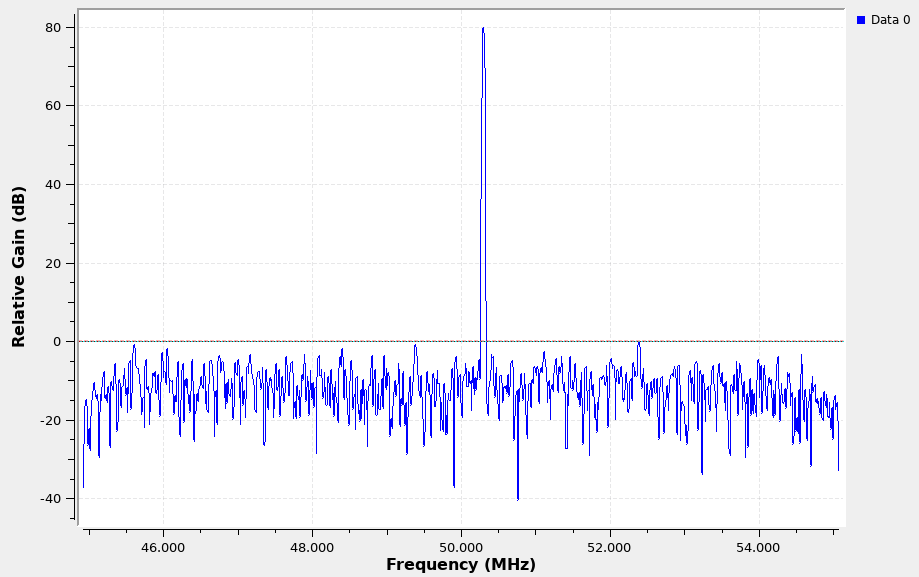
Rx Dynamic Range at 525 MHz
Figure 18: Spectrum of 525 MHz Rx Waveform under Max Dynamic Range conditions
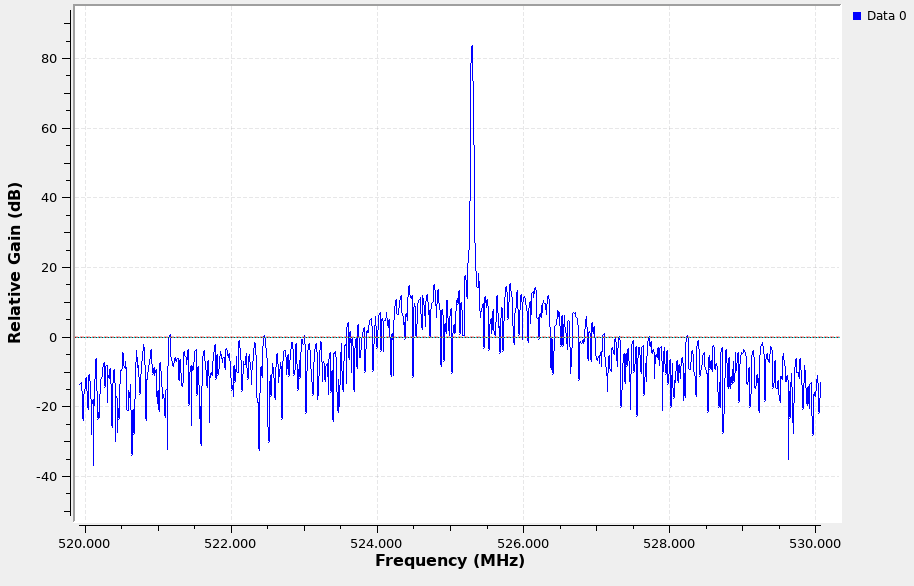
Rx Dynamic Range at 1.5 GHz
Figure 19: Spectrum of 1500 MHz Rx Waveform under Max Dynamic Range conditions
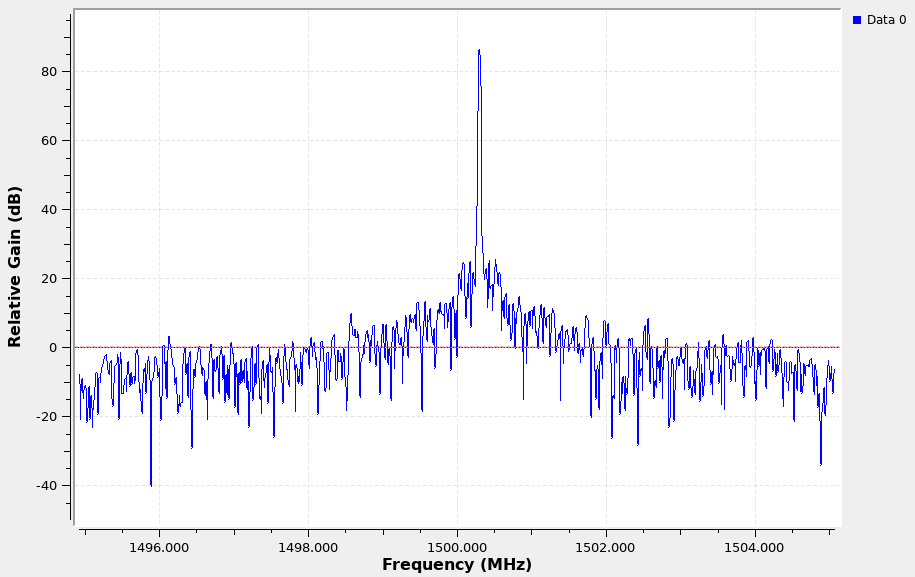
Rx Dynamic Range at 2.8 GHz
Figure 20: Spectrum of 2800 MHz Rx Waveform under Max Dynamic Range conditions
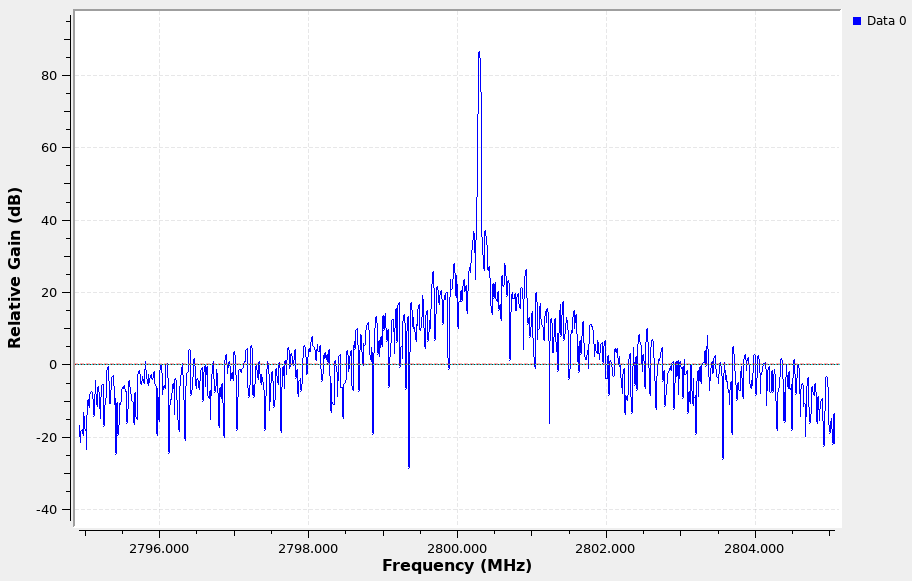
Rx Dynamic Range at 4.2 GHz
Figure 21: Spectrum of 4200 MHz Rx Waveform under Max Dynamic Range conditions
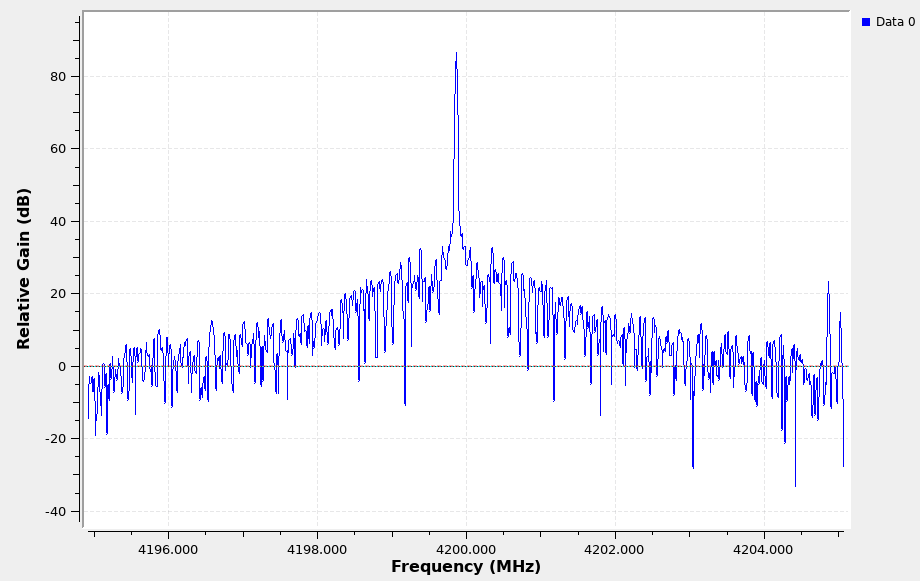
Rx Dynamic Range at 5.1 GHz
Figure 22: Spectrum of 5100 MHz Rx Waveform under Max Dynamic Range conditions
